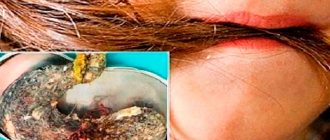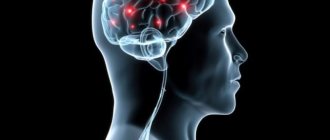Schizoaffective disorder (schizoaffective psychosis) is a condition that simultaneously combines the psychotic symptoms of schizophrenia (delusions, hallucinations) and signs of a mood disorder (depressive and manic).
This pathology is an intermediate link between schizophrenia and bipolar disorder. Due to the combination of elements of different mental illnesses, making a diagnosis presents difficulties that only a specialist with extensive experience can handle. At the same time, it is important to recognize the disease as early as possible - the longer no help is provided, the higher the risk of a protracted, poorly controlled course and worsening of symptoms.
Schizoaffective disorder is an intermediate condition between schizophrenia and bipolar affective disorder.
The set of symptoms is called affective-paranoid syndrome. This concept includes two types of manifestations of the disease:
- Depressive-paranoid syndrome is a low mood with hallucinations and delusions of a negative, self-blaming nature.
- Manic-paranoid syndrome is an elevated mood with hallucinations and delusions of a praising nature.
There may be ideas of persecution or influence from ill-wishers, otherworldly forces, alien creatures.
All this leads to severe social dysfunction, contributes to the emergence of suicidal thoughts and intentions, and significantly increases the path to healing. With timely treatment, the disease is successfully controlled, and patients return to normal life and work.
Factors that increase the risk of developing schizoaffective psychosis:
- genetic - having a close relative with schizophrenia, schizoaffective disorder or mood disorder;
- drug use (LSD, cocaine, opiates);
- stressful situations.
There are manic, mixed and depressive types of disorder, each of which is characterized by its own unique symptoms.
Schizoaffective disorder manic type
This variant is characterized by an abrupt onset and vivid symptoms. Schizophrenic symptoms are combined with manic manifestations. Mania in schizophrenia is characterized by sharply elevated mood, delusional ideas of grandeur or persecution, motor agitation, and lack of social inhibition. There is a pathology of desires (increased sexual activity, appetite), aggression is possible.
Manic syndrome is a pathologically elevated mood with agitation. A person grabs hold of everything, gives away property, and can spend many years of savings at once.
In manic schizophrenia, the symptoms of a mood disorder are expressed by the following main manifestations:
- accelerated thinking, distracted attention, slipping from topic, incoherent speech;
- hyperactivity, decreased need for rest and sleep;
- a sharp increase in mood that does not go away even in situations in which this would be expected.
To make a diagnosis, schizophrenic symptoms must also be present: auditory and visual hallucinations, delusions of various contents. This includes delusions of physical influence: a person’s belief in the influence of certain physical forces on him - an electric field, witchcraft, radiation. A frequent variant is delusion of attitude: he perceives all neutral events and remarks not related to the patient as having a negative meaning for him.
Important
If you suspect signs of a mental disorder in yourself or a loved one, you should immediately contact a specialist. Further uncontrolled development of symptoms leads to a worsening of the condition, the emergence of a difficult situation in the family and poses a danger to children and the environment.
It is worth noting the increased risk of developing manic schizophrenia in women in the postpartum period. Hormonal changes, psychological and physical stress are the trigger for the development of the disorder.
Symptoms
The clinical picture of schizoaffective psychosis combines various symptoms that are characteristic of affective disorder and classical schizophrenia:
- loss of appetite, which provokes weight loss or gain, which is caused by a serious metabolic disorder;
- sleep disturbance, which is expressed by insomnia, drowsiness, nightmares;
- increased excitability, which causes nervous breakdowns and high aggressiveness;
- rapid onset of fatigue as a result of minimal exertion;
- lack of interest in anything, acute manifestation of laziness;
- the appearance of an inferiority complex and guilt towards certain people, which develops into a feeling of fatality and the impossibility of changing fate;
- loss of concentration and attention, the intellect is in a foggy state, mental activity is difficult;
- the appearance of thoughts of suicide;
- the appearance and increase of sexual desire in the form of perverted forms;
- accelerated speech, incoherence and illegibility in certain situations;
- during periods of exacerbation, a person becomes dangerous to others - he reacts aggressively to any criticism, gets involved in conflicts using force;
- delusional statements and ideas appear, manifested in long monologues about events not related to the situation in which the person is;
- intelligence declines sharply, mental work becomes difficult, and dementia manifests itself;
- during periods of overwork and difficult experiences, the patient experiences auditory and visual hallucinations; most often he hears voices that give advice, instructions and comment on what is happening;
- the patient's behavior becomes unpredictable and illogical;
- illogical expression of emotions that do not correspond to the situation (crying when everyone is laughing, laughter at a funeral).
Alcohol and drug use worsen all symptoms. The disease progresses and develops into the most difficult stage - manic-type schizophrenia, when detected, the person is isolated from society and placed in a special medical institution.
Schizoaffective disorder depressive type
This option combines schizophrenic symptoms with depressive symptoms. The patient is lethargic, inhibited, and experiences feelings of emptiness, sadness and a sense of worthlessness. To this are added hallucinations and delusions typical of schizophrenia.
Main manifestations of depression:
- depression, melancholy;
- loss of interest in life and previous activities;
- fatigue, decreased energy potential, sleep disturbances;
- feelings of guilt and uselessness;
- memory and concentration problems.
The picture of a characteristic depressive-paranoid syndrome includes delusions of various topics. Blaming delusions - a person is convinced that others consider him guilty of committing shameful acts or crimes. With delusions of harm, the patient is sure that they intend to harm him, to rob him. A common variant is delusions of persecution, when a person believes that he is being spied on by military organizations or pursued by witchcraft forces. All this happens against the background of pronounced depressive symptoms.
Important
Depressive syndrome cannot be ignored by a specialist: in the best case, a person stops working, leaving the house, taking care of himself, in the worst case, he may commit suicide.
With this type, the episodes are not as vivid as with manic, but they cannot be ignored. Diagnosis and treatment of schizoaffective disorder of the depressive type must begin as early as possible, because without the intervention of a specialist, this condition tends to last a long time and often leads to suicidal actions.
Reasons for development
The exact causes of schizoaffective psychosis have not yet been fully studied by modern medicine. It is not yet possible to accurately indicate the factors that influence the occurrence of this disease. Today, a number of reasons that can cause the disease are considered:
- Genetic predisposition. Several years ago, geneticists identified the so-called risk gene for schizophrenia. Every person has such a gene, but the causes of the disease have not yet been clarified. It has also been proven that schizoaffective disorder can be inherited from parents suffering from this illness. There have been debates around the world for many years about the mandatory sterilization of people diagnosed with schizophrenia.
- Intrauterine factors. Today, psychiatrists are increasingly suggesting that predisposition is laid down during the formation of a child in the womb of the mother. The development of the disease is possible if the mother had nervous breakdowns or depression during pregnancy. Long-term studies have shown that recurrent schizophrenia most often manifests itself in people born in late winter and early spring.
- Social and everyday reasons. Schizoaffective psychosis can occur against the background of discrimination, living conditions, forced relocation due to wars and disasters. In these cases, the disease most often manifests itself in lonely people who do not have support.
- Drug use and chronic alcoholism can trigger schizoaffective disorder. Often a person tries to break out of the circle of his psychological suffering with the help of bad habits.
Diagnostics
When symptoms of a mental disorder appear, the doctor collects a medical history and prescribes a full examination. There are no tests in medicine that accurately determine schizoaffective psychosis. Tests can exclude various diseases of other systems that cause similar symptoms. If the results of tests and examinations fail to find other diseases, the patient is referred to a psychotherapist. These specialists use developed methods for identifying mental illnesses. The diagnosis of recurrent schizophrenia is made only if the continuity of the disease and its accompanying symptoms are confirmed. Such symptoms should be observed for at least 2 weeks.
How does bipolar disorder manifest?
The difficulty in diagnosing the problem lies in the fact that it is characterized by symptoms of both schizophrenia and affective disorder. It all starts, as a rule, with auditory hallucinations. A person may hear distant voices and believe that everyone around him is commenting on his actions. In a neglected state, the patient thinks that those around him read his thoughts. This causes attacks of panic and fear.
The disorder continues with the manifestation of symptoms such as the patient suddenly freezing in one position, delirium and loss of the semantic component of his speech.
In addition, schizoaffective disorder occurs with the presence of symptoms characteristic of affective mental disorders. For example, the need for sleep gradually decreases, the speed of word reproduction increases, grandiose plans begin to arise and delusions of grandeur develop.
Such mixed symptoms greatly overload the nervous system. If nothing is done, there is a high risk for the patient to lose awareness and adequacy.
Schizoaffective disorder: causes
Schizoaffective disorder is classified as a so-called third endogenous psychosis. It is, relatively speaking, at the intersection of schizophrenia and bipolar affective disorder (BAD), which according to the old classification is also referred to as manic-depressive psychosis. Or the BALL occupies a place, as it were, at the closest pole to the border with affective psychoses.
Endogenous diseases have a genetic basis, which is already hidden in the prefix “endo”, that is, “internal”. The concept of “endogenous” arose even before genetics appeared. Today, this term has been preserved and denotes a hereditary basis, that is, genetic. The likelihood of developing schizoaffective disorder increases if a person has relatives who have suffered from schizophrenia spectrum diseases.
Previously, it was believed that certain conditions were necessary for genes to “express themselves.” It was assumed that the likelihood of manifestation of certain genes depends on factors affecting the development of the fetus during the prenatal period (hypoxia, starvation, infections). It was also believed that the social environment in childhood and adolescence plays a significant role. But at the present stage it has become clear that all these factors can only be push factors – trigger ones – in the manifestation of the onset of schizophrenia and schizoaffective disorder (recurrent schizophrenia) in particular.
Prospects for treatment
Unfortunately, schizoaffective disorder is an incurable disease. Treatment helps reduce symptoms and flare-ups of the disease. A person must constantly take psychotropic medications, periodically undergo studies and treatment in specialized medical institutions.
The childhood form of schizoaffective disorder, when identified at an early age, can be treated because the child’s psychological state is still developing and can be corrected with the right approach.
Treatment
Treatment of schizoaffective disorder is a long-term process that combines the use of various techniques.
The most effective treatment is the use of medications. The choice of drugs depends on the degree of neglect of the disease. They are aimed at suppressing symptoms. Antidepressants, antipsychotics and stabilizers are used.
The second treatment method is psychotherapy. Its goal is for the patient to learn more about his disease, organize his thoughts, and identify the main goals in life that will help fight the disease.
Family psychotherapy is actively used, which is designed to teach actions that help the patient and his relatives integrate into society.
The patient is taught personal hygiene, the ability to do housework, behavior in crowded places, etc.
In 80% of cases, patients with schizoaffective psychosis are hospitalized in a psychiatric hospital. In case of suicidal symptoms and manifestation of causeless aggression, the patient is hospitalized immediately.
Schizoaffective disorder in children
Today, psychiatrists very often encounter schizoaffective disorder in children in practice. The cause of its occurrence is genetic inheritance. Such children have reduced weight, a reduced level of intelligence, and increased emotionality. They are characterized by problems establishing contacts with peers, greater dependence on parents, bad behavior and poor performance at school. The first symptoms of schizoaffective psychosis manifest themselves in the form of sleep disturbances, constant fears, mood swings, and excessive fantasizing. Parents should be wary if their child constantly plays with imaginary friends. Unreasonable aggression can manifest itself in constant school fights and bullying of peers and animals. As a rule, children with schizoaffective disorder are born to parents with psychological illnesses and older couples.










